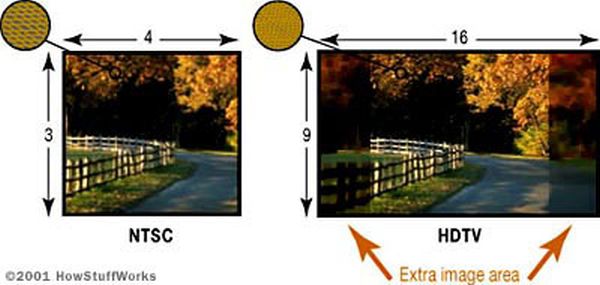Analog, Digital and HDTV
For years, watching TV has involved analog signals and cathode ray tube (CRT) sets. The signal is made of continually varying radio waves that the TV translates into a picture and sound. An analog signal can reach a person’s TV over the air, through a cable or via satellite. Digital signals, like the ones from DVD players, are converted to analog when played on traditional TVs. (You can read about how the TV interprets the signal in How Television Works.)
This system has worked pretty well for a long time, but it has some limitations:
- Conventional CRT sets display around 480 visible lines of pixels. Broadcasters have been sending signals that work well with this resolution for years, and they can’t fit enough resolution to fill a huge television into the analog signal.
- Analog pictures are interlaced — a CRT’s electron gun paints only half the lines for each pass down the screen. On some TVs, interlacing makes the picture flicker.
- Converting video to analog format lowers its quality.
United States broadcasting is currently changing to digital television (DTV). A digital signal transmits the information for video and sound as ones and zeros instead of as a wave. For over-the-air broadcasting, DTV will generally use the UHF portion of the radio spectrum with a 6 MHz bandwidth, just like analog TV signals do.
DTV has several advantages:
- The picture, even when displayed on a small TV, is better quality.
- A digital signal can support a higher resolution, so the picture will still look good when shown on a larger TV screen.
- The video can be progressive rather than interlaced — the screen shows the entire picture for every frame instead of every other line of pixels.
- TV stations can broadcast several signals using the same bandwidth. This is called multicasting.
- If broadcasters choose to, they can include interactive content or additional information with the DTV signal.
- It can support high-definition (HDTV) broadcasts.
DTV also has one really big disadvantage: Analog TVs can’t decode and display digital signals. When analog broadcasting ends, you’ll only be able to watch TV on your trusty old set if you have cable or satellite service transmitting analog signals or if you have a set-top digital converter.
This brings us to the first big misconception about HDTV. Some people believe that the United States is switching to HDTV — that all they’ll need for HDTV is a new TV and that they’ll automatically have HDTV when analog service ends. Unfortunately, none of this is true.
HDTV is just one part of the DTV transition. We’ll look at HDTV in more detail, including what makes it different from DTV, in the next section.
Important Digital TV Dates
As of March 1, 2007, all new TV sets in the U.S. had to have DTV tuners or be DTV ready. But the transition to digital TV isn’t complete. Feb. 17, 2009 is the proposed shutoff date for over-the-air analog broadcasts.
For more detail: How HDTV Works

